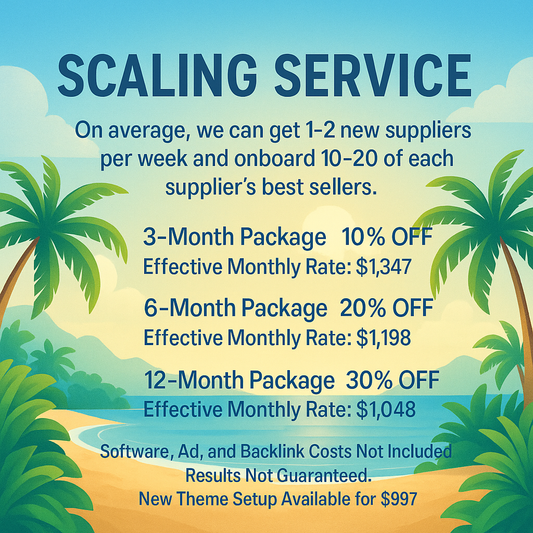Technical SEO for Shopify: The Hidden Fixes That Unlock Rankings
How to improve your site’s speed, structure, and crawlability for better search results
If you’ve already optimized your content, built backlinks, and created a great store structure — but your rankings still aren’t climbing — there’s a good chance your technical SEO needs work.
Technical SEO isn’t about writing or marketing. It’s about making your Shopify site easy for Google to crawl, index, and understand — so it can rank your content properly.
This post covers the most important technical SEO improvements you can make to your store right now.
What Is Technical SEO?
Technical SEO refers to the backend, code-level, and site-wide improvements that impact how search engines interact with your site. It ensures your store loads fast, works well on mobile, and is structured in a way that Google can easily read.
Even if you have the best products and content, poor technical SEO can block your growth.
Why Technical SEO Matters for Shopify Stores
Shopify is great for ecommerce — but it’s not perfect out of the box for SEO. Some themes are slow, some apps add bloat, and most store owners never touch their sitemap or structured data.
By improving your technical SEO, you can:
-
Speed up your site
-
Improve crawlability and indexing
-
Help Google understand your products and collections
-
Provide a better user experience (which also helps SEO)
Technical SEO Checklist for Shopify
Here are the top things you should focus on:
1. Improve Site Speed
Use Google PageSpeed Insights or GTmetrix to test your site speed. Aim for a load time under 3 seconds.
Quick wins:
-
Compress large images (use WebP or JPEG)
-
Use a fast, lightweight Shopify theme
-
Limit how many apps you install
-
Avoid autoplay videos and large GIFs
2. Make Sure Your Site Is Mobile-Friendly
Most Shopify themes are responsive, but you should still double-check.
Use Google’s Mobile-Friendly Test to confirm.
Mobile experience is now a major ranking factor — and most traffic is mobile anyway.
3. Submit Your Sitemap to Google
In Shopify, your sitemap is located at:yourdomain.com/sitemap.xml
Submit it in Google Search Console. This helps Google find all your important pages faster.
4. Fix Crawl Errors and Broken Links
Use tools like:
Fix 404 errors, redirect broken links, and ensure all key pages are accessible and indexable.
5. Use Schema Markup (Structured Data)
Schema helps Google display rich results like star ratings, product info, pricing, and FAQs.
Install a Shopify app like JSON-LD for SEO to automatically add schema to your products and blog posts.
Add:
-
Product schema (name, price, availability, reviews)
-
FAQ schema for common questions
-
Review schema for customer ratings
6. Avoid Duplicate Content
Shopify can generate duplicate content in a few ways — mostly through product variants, tag pages, and collection sorting.
How to fix it:
-
Use canonical tags (Shopify adds these automatically, but double-check with SEO apps)
-
Avoid creating unnecessary duplicate collections or filtered pages
-
Don’t use the same product descriptions across multiple products
7. Set Up Proper Redirects
If you discontinue a product or change a URL, set up a 301 redirect using Shopify’s built-in URL redirects. Never leave a dead page behind — it wastes link equity and causes user drop-off.
8. Use a Clean Site Structure
Keep every important page within 2–3 clicks from the homepage. Avoid creating deep folder paths or orphaned pages with no internal links.
You can learn more about this in our post on Shopify Site Structure for SEO.
Pro Tip
Do a technical SEO audit every 1–2 months. This helps you catch crawl errors, unindexed pages, slow load times, and other hidden issues before they affect your rankings.
You don’t need to be a developer to do this. Free tools + the right apps + a basic checklist can take you 80% of the way.
Technical SEO Summary Checklist
-
Ran a speed test and optimized images
-
Confirmed mobile responsiveness
-
Submitted sitemap to Google Search Console
-
Fixed 404 errors and crawl issues
-
Installed product/review/FAQ schema
-
Avoided duplicate content from tags and filters
-
Created redirects for discontinued or changed URLs
-
Verified internal linking and site structure
Want Help?
If you want expert eyes on your technical SEO setup — or help fixing these issues fast — we’ve got your back.
Download the Ultimate SEO Checklist
Book a Free SEO Audit
Join the Ecommerce SEO Course + Discord Community
Next up: How to track your progress and scale what’s working using analytics and optimization tools.


















